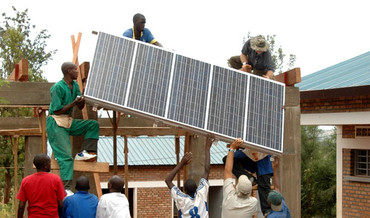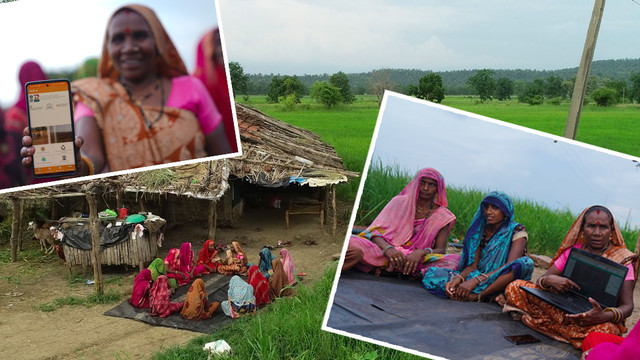The private sector’s role in low carbon resilient development
The private sector is playing a role in reducing the impacts of climate change, called climate change mitigation, and, to a more limited extent, is helping societies adapt to climate change. But how might the private sector better engage with the two agendas together, in what has been called low carbon resilient development?


A solar lamp lights up a shop. It’s often easier and more profitable to distribute lamps than to support longer-term changes within a community that could build resilience to the impacts of climate change. Credit: Copyright Andy Maluche
Private sector: important role to play
As public finances become increasingly constrained, there is a clear need to find resources from elsewhere to support the move to a low carbon resilient society. Clearly, the private sector has an important role to play in building a low-carbon, climate resilient future for the planet.
Some companies are already hard at work developing weather-based insurance products that provide financial pay outs to farmers in the event of a drought or a flood, for example, allowing farmers to hedge against the risks that are becoming more acute due to the impacts of climate change. Other companies are co-financing infrastructure projects while others are making their own supply chains and business operations more climate resilient.
New international and national policies are aimed at encouraging these private actors. Examples include the UN Framework Convention on Climate Change, which has a Private Sector Initiative to catalyse the role of the private sector in climate adaptation, and forms of climate finance, such as the Climate Investment Funds, which place a special emphasis on involving the private sector in resilience.
But the private sector has generally focussed on climate mitigation by, for example, reducing emissions through developing renewable energy and energy efficient technologies. Financing adaptation has been less of a strong point, and this risks being left out.
For example, solar lanterns may be sold to communities without access to electricity by private companies. The lanterns are low carbon (as they are a renewable source of energy) and can increase the resilience of families to the impacts of climate change by offering them a cheaper and reliable source of light, and don’t create the health problems caused by burning wood or charcoal, which is a major cause of disease. This allows families to save money, stay healthy and allows children to study and do better at school. All of these factors will make a family more climate resilient and so recover more quickly to any unexpected shocks, such as a flood or a drought.
Incentives for private sector involvement might be stronger around the distribution of the lanterns than for ensuring the communities who receive them have been well chosen, and that the lamps do really build increased resilience. That’s because it’s easier and more profitable to distribute lamps than to support longer-term changes within a community to build further resilience by, say, starting a saving scheme from money saved, or using the extra light to diversify livelihoods by undertaking work in the home, such as sewing.
But both climate adaptation and mitigation are an important part of low carbon resilient development. So how can the private sector address both? Here are some questions that might bring us closer to having some answers.
Who is the private sector in low carbon resilience: hopes vs reality?
The term “private sector” is widely used in the climate debate but it’s not often clear who this private sector is, nor what its capacities and incentives are for engaging in climate policies. Definitions vary according to context and will directly impact on what role it might play.
These are important questions for countries such as Rwanda and Ethiopia, which have included plans for private sector engagement and financing in their low carbon resilient national strategies. Read more about Rwanda’s plan or about Ethiopia’s.
Given that neither country has a history of a strong private sector or private investment, their plans are ambitious.
In Ethiopia the private sector is largely trader based in the agricultural, manufacturing and service sectors and the diaspora is also a potential source of investment. In Rwanda, small and medium-sized enterprises make up the majority of the private sector and are unlikely to be a significant source of investment at this point.
Despite the differences, in both of these cases, it’s not clear how either country’s private sector might become a source of additional climate finance. At present there is a gap between the hoped for private sector funds and the amounts currently available for funding a national strategy. For the national governments to realise their aspirations, catalysing the private sector will be key.
How can the public sector support private sector engagement?
The Rwandan government is using national and donor funding to create financial incentives for the private sector to get involved. It has kept 20% of funding from their national climate fund (FONERWA) for private sector companies. It’s doing this because it hopes the private sector will play a role in co-financing and offering more sophisticated financial products, such as loans for developing innovative climate change solutions that will become profitable over time . There have also been new partnerships established between the public and the private sector to try and catalyse Rwandan businesses to engage. The Private Sector Federation in Rwanda (a professonal body) is working with the government to train small and medium-sized enterprises across the country on potential financial opportunities related to Rwanda’s climate change policies.
Ethiopia has also been working with small and medium-sized enterprises (SMEs) so they can support the country’s low carbon climate resilient agenda. For example, the National Biogas Programme has organized and trained several hundred SMEs in biogas construction and maintenance. The Government of Ethiopia is now working on using the same model for the implementation of an Off-Grid Electrification national programme, which aims to distribute solar panels to people’s homes.
What are the incentives to bring together low carbon policies with climate resilience?
Profits, new markets and the development of new innovations could provide clear incentives for the private sector to become involved in building a low-carbon, climate-resilient future. But there’s a risk that these profitable “easy wins”, such as distributing solar lanterns, are over-emphasised and building climate resilience gets overlooked. Building resilience is a longer, more complex process and it is also harder to know when this aim has been achieved. It is much easier, for example, to measure the number of lamps sold, than the increased wellbeing and resilience of a community.
Finding ways to measure and monitor resilience will help tie in building resilience with climate mitigation actions that may be more financially profitable. This could make building resilience more attractive to the private sector.
However, in the current situation the market alone is not providing sufficient incentive for this to happen and, at least initially, these incentives need to be created by national governments or the international community.
If we can find answers to these questions there’s a chance that we could bring about low carbon resilient development that helps build local resilience to the impacts of climate change and reduces greenhouse gas emissions.




